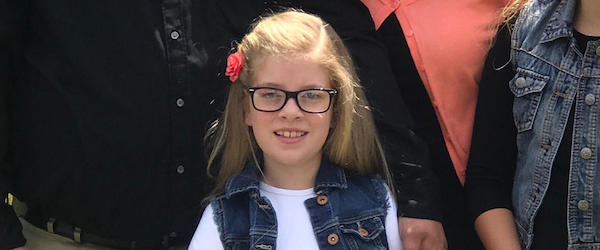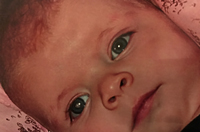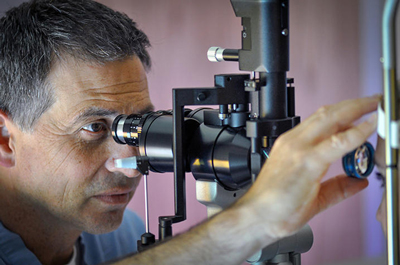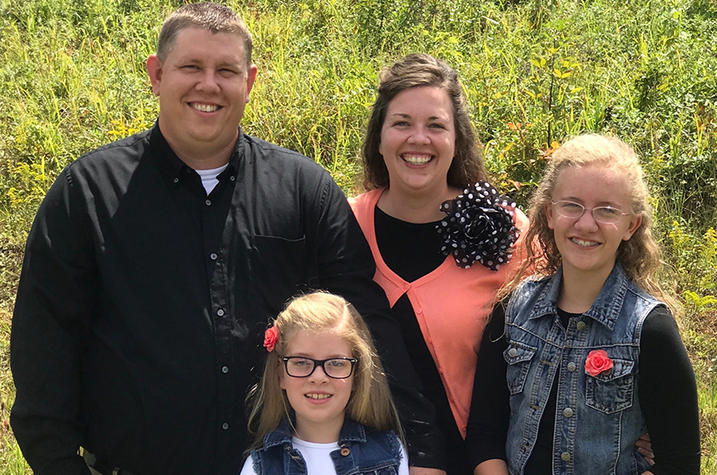Diagnosing eye cancer early preserves girl’s sight

When Kenley Overton’s parents took their infant daughter in for her four-month wellness checkup, they didn’t know much about retinoblastoma, the rare form of eye cancer that most commonly affects children. But that quickly changed.

Kenley was born Aug. 24, 2010, to Jason and Kendra Overton. When Kenley was a few weeks old, her parents noticed that her right eye would cross frequently. They brought it up to their local pediatrician during a wellness checkup and were told that it wasn’t abnormal for newborns.
However, when the Overtons brought Kenley in for her four-month wellness checkup, her right eye was still crossing. The pediatrician suggested Kenley see an eye doctor as it was likely she would need glasses to fix the issue.

In a whirlwind of appointments, Kenley first saw an optometrist who believed she had a detached retina. She was then referred to Dr. Peter J. Blackburn at UK Advanced Eye Care. After some testing, Blackburn diagnosed Kenley with retinoblastoma – a form of eye cancer that begins in the retina. Thirteen days after her wellness check, Kenley was scheduled for surgery with Blackburn to evaluate the situation and decide on a plan moving forward.
The best-case scenario
Retinoblastoma is a rare disease; only 200 to 300 children are diagnosed with it each year in the U.S. About three out of four children with retinoblastoma have a tumor in only one eye. Overall, more than 90 percent of children with retinoblastoma are cured, but the outlook is not nearly as good if the cancer has spread outside the eye.
Blackburn says that although there are no known avoidable risk factors for retinoblastoma, some gene changes that put a child at high risk for the condition can be passed on from a parent. Children born to a parent with a history of retinoblastoma should be screened for this cancer starting shortly after birth because early detection greatly improves the chance for successful treatment.
When Blackburn came out of surgery, he told the Overton family that Kenley’s cancer was only in her right eye – the best-case scenario.
He was pleasantly surprised because at Kenley’s young age, he had suspected the cancer might have been in both of her eyes. The decision was made to remove Kenley’s right eye that day.
In the years following her surgery, Kenley was regularly monitored to make sure the cancer hadn’t spread to her left eye. As Kenley continued to grow and show no signs of the retinoblastoma in her left eye, Blackburn became more confident that the cancer was limited to Kenley’s right eye.
Compassionate care at UK
Kendra Overton looks back on this difficult time in Kenley’s life and remembers how tough it was on her family. While taking care of Kenley, she and Jason also had to care for their older daughter, Jaylen, who was 4 years old at the time. But through the stress, she remembers Blackburn and the care he provided for Kenley.
“Dr. Blackburn was a very confident in the information he delivered about Kenley and her treatment plan, and he had a wonderful bedside manner,” she said.
She said Blackburn even took the time to pray with her family before Kenley’s surgery.
“At a time when we were falling apart, we really needed that and you don’t normally hear of doctors doing that,” she said.
Kenley is now a thriving 6-year-old. Kendra describes her daughter as naturally funny and someone who never meets a stranger. She just has a love for people, her mother says.
“Everyone who comes in contact with her says she is just so amazing,” Kendra said.






